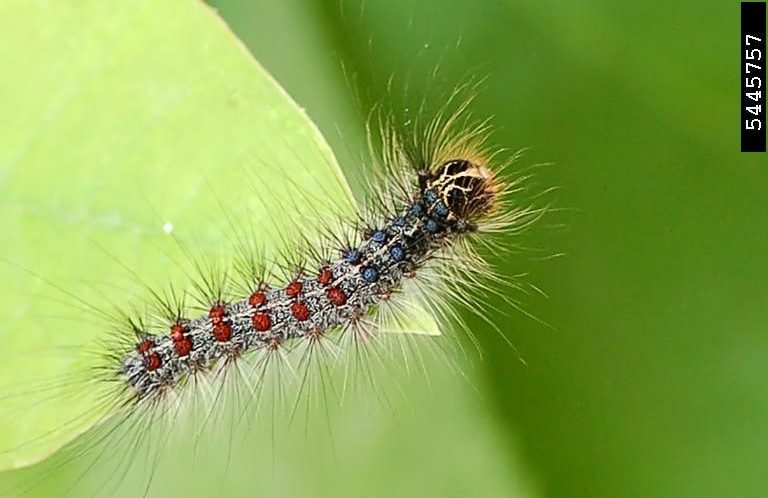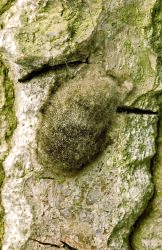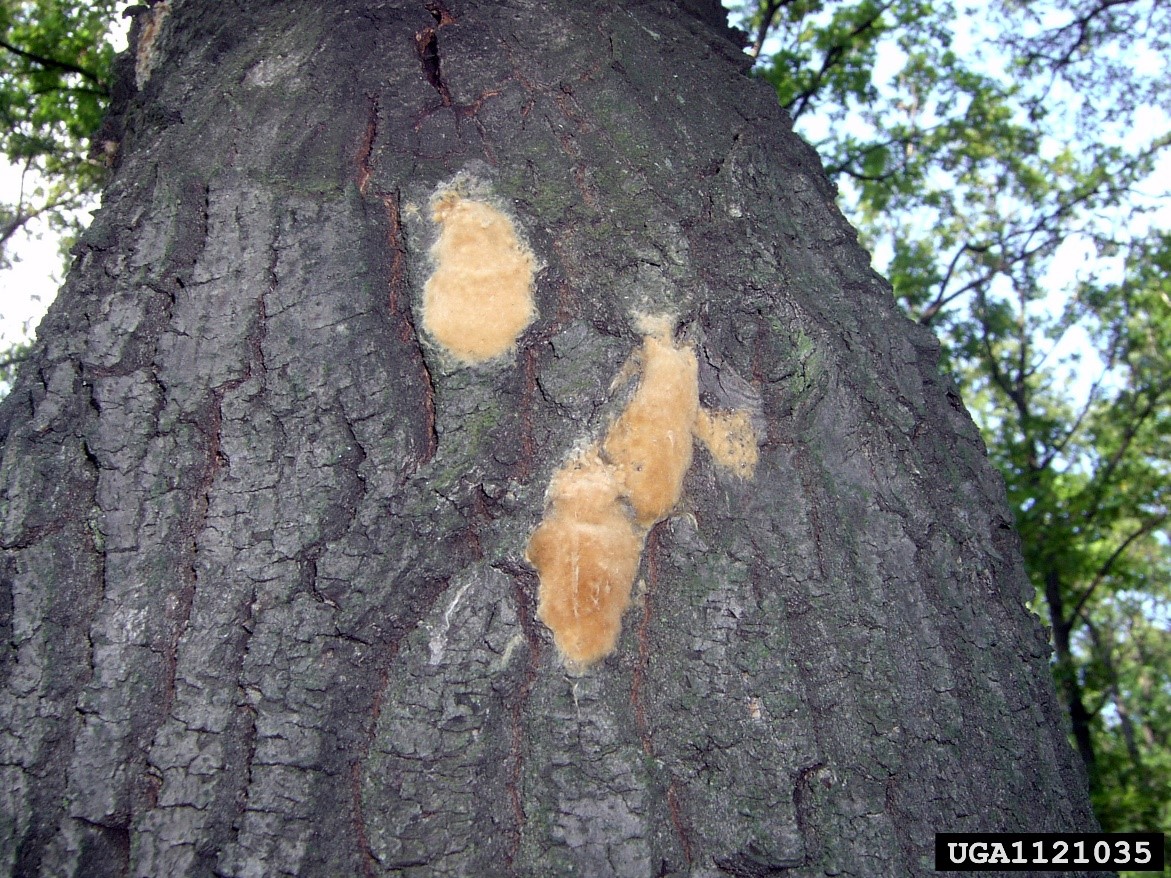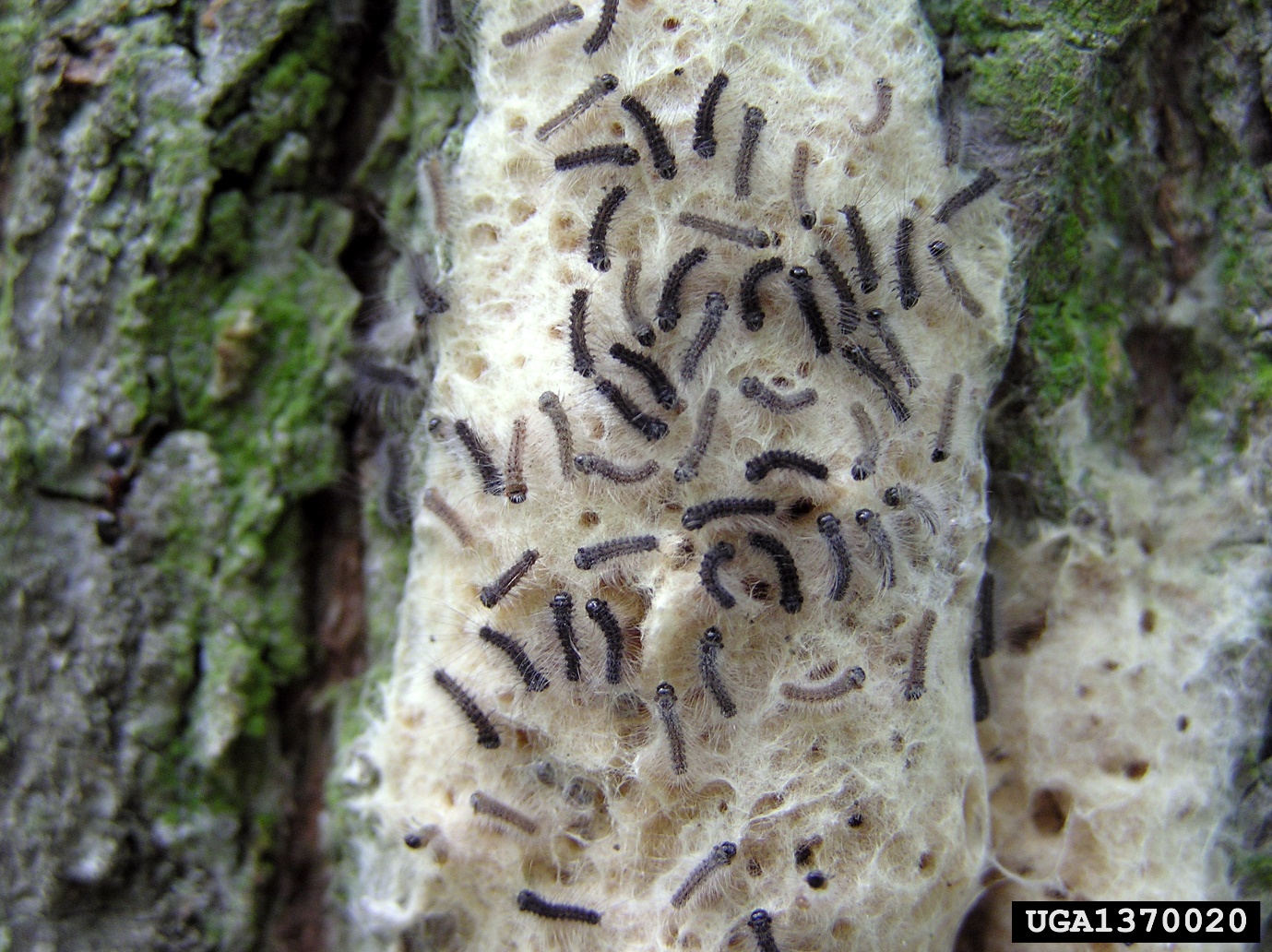Present in United Kingdom
Not notifiable – see ‘Report a sighting’ below
Scientific name – Lymantria dispar (L. dispar)
 Picture: Mature gypsy moth larva – Jon Yuschock, Bugwood.org
Picture: Mature gypsy moth larva – Jon Yuschock, Bugwood.org
The larvae, or caterpillars, of gypsy moth (Lymantria dispar) are an important defoliator of a wide range of broadleaved trees and shrubs.
Gypsy moth is found throughout much of London, and patchily in the south-east of England. It is native to parts of continental Europe, where populations periodically reach very high numbers.
Gypsy moth caterpillars feed on the leaves of a variety of broadleaved tree and shrub species, showing a preference for oaks (trees in the Quercus genus) and poplars (Populus species) in forest situations.
They will also feed on many species of small trees and shrubs in gardens, including ornamental conifers, and especially in hedges: hedges of beech (Fagus spp.) are a frequent target.
Gypsy moth caterpillars’ damage can be extensive when population densities are high, and it is most severe on small trees. A host plant will usually recover after an infestation without its vigour being affected. However, repeated infestations can negatively impact the plant’s long-term health, and can eventually lead to tree death.
Gypsy moth hairs do not cause severe adverse side effects to human health, unlike oak processionary moth hairs. However, as with all hairy caterpillars, the hairs are potential allergens, although symptoms vary depending on an individual’s susceptibility. Touching any caterpillar with long hairs is usually best avoided.
Eggs
Gypsy moth eggs are laid in large plaques, 3-4 cm long, and covered in yellowish/ brown hairs deposited by the female. These hairs help to protect the eggs over winter. The plaques are usually found on crevices of bark, as in the pictures below, but in urban situations they can also be found on walls, fences or any other sheltered, rough surface.


Picture: Daniela Lupastean, University of Suceava, Bugwood.org
Larvae
When freshly hatched, gypsy moth larvae, or caterpillars, are small: about 2 mm long, dark coloured, and very hairy, as in the picture below.

Picture: Milan Zubrik, Forest Research Institute – Slovakia, Bugwood.org
As the caterpillar grows, its body colour lightens, and becomes a brownish-yellow grey with black markings. The yellow and black head is easily seen from the front.
The mature caterpillar develops a series of distinctly coloured ‘warty spots’ along its back: five pairs of blue spots behind the head, and six pairs of red spots to the rear. These spots are an easy way to distinguish the caterpillar from other, similar species.
The caterpillars shed their skins several times to accommodate their growing bodies, and are usually fully grown by June; mature caterpillars can reach lengths of 60-70 mm.
There is no statutory requirement to notify sightings of gypsy moth to the plant health authorities. However, if serious damage has occurred or you want further information, reports and enquiries can be submitted to us through our TreeAlert on-line pest reporting tool.
If you cannot use TreeAlert, which requires a photograph to be uploaded, contact our Tree Health Diagnostic & Advisory Service.
Gypsy moths complete one generation per year in the UK. The species overwinter as eggs before the larvae (caterpillars) emerge in spring, usually in April and May.
The tiny, newly hatched larvae then crawl towards the top of their host plant, suspend themselves by silk threads, and passively disperse into the wider environment via the wind. This process is known as ballooning. Most balloon flights end with a very short dispersal, but in very rare instances flight distances can be considerable.
Gypsy moth caterpillars grow quickly, with the larger females reaching up to 70 mm long after four to six weeks, before pupation begins in June or July.
Pupation takes 10 to 14 days, after which the sexually dimorphic* adults (moths) emerge, usually in July, when they mate and lay eggs. Males are smaller than females. The females have reduced wings, are largely flightless, and depend on releasing potent sex pheromones to attract males.
Once mated, the females lay a plaque of between 50 and 800 eggs measuring 3-4 cm by 1.5-2.0 cm. These are covered by yellowish-brown hairs deposited by the female, and the eggs will overwinter in this form. Newly laid eggs are bright yellow and firm; hatched eggs in spring are soft and spongy.
*Dimorphic – the condition where the two sexes of the same species exhibit different characteristics beyond the differences in their sexual organs.
If you suspect a gypsy moth colony outside the main distribution area in South-East England, you should report the sighting to us with our Tree Alert pest reporting tool, particularly if the caterpillars are causing significant defoliation. Our Tree Health Diagnostic & Advisory Service can advise on management and information from reported sightings, which are crucial for monitoring spread and potential increases in damage.
Forest Research has previously used pheromone traps to monitor gypsy moth in London and Aylesbury, but we no longer carry out regular surveys. We know gypsy moth is now widely but thinly spread across a large part of South-East England, and we continue to collate records and monitor population trends.
The UK had a native population of gypsy moth in the fens (wetlands) of eastern England, but it became extinct in the early 1900s after the habitat was drained. It fed on the bog-myrtle (Myrica gale) and creeping willow (Salix repens) plants of the fens.
A small colony of the polyphagous* European population was discovered in June 1995 near Epping Forest in north-east London. The source of the outbreak is still unknown. However, because the females are largely flightless, it is likely that eggs were transported from mainland Europe in vehicles, wooden packaging and/or imported timber.
Since this initial introduction, the species has spread to much of London and parts of South-East England.
*Polyphagous – able to feed on various types of food
Information current as of May 2020.